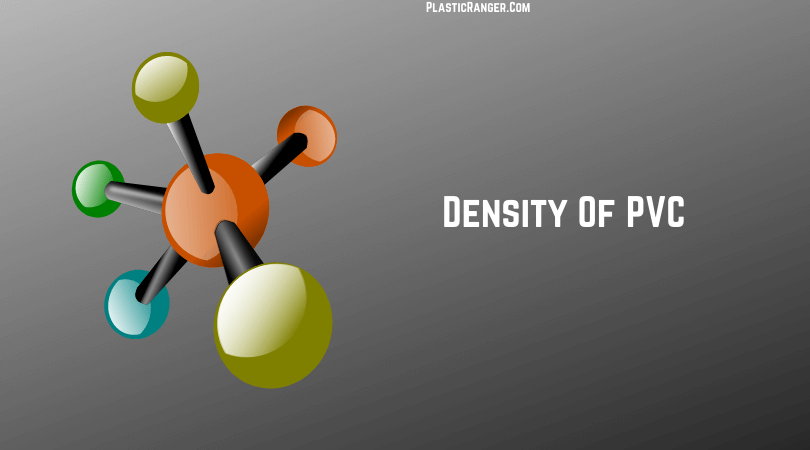Density of PVC
A plastic material’s density is described as the mass per unit volume of a material, generally measured in grams per cubic centimeter (g/cm³) or kilograms per cubic meter (kg/m³).
The density of PVC typically falls between 1.44 and 1.48 g/cm³, or 1330 kg/m3. This parameter isn’t fixed but fluctuates depending on the use of different additives. The incorporation of stabilizers, fillers, and plasticizers into PVC can result in variations in its density.
These additives can either escalate or diminish the density of the PVC material.
Before taking a deep dive into PVC density, I’d like to clarify the definition of the Density of a plastic and how it is measured.
What is Density?
Plastic Density measures the mass of a substance per unit volume. It is a fundamental physical property that can identify a material and determine its behavior under different conditions.
A material’s density can be expressed in grams per cubic centimeter (g/cm³) or kilograms per cubic meter (kg/m³).
Factors Affecting the Density of PVC
The density of PVC varies depending on its formulation and manufacturing process. The basic PVC resin has a density of about 1.44 g/cm³.
However, the density can vary depending on additives, such as stabilizers, fillers, and plasticizers.
The presence of these additives can increase or decrease the density of the material.
Fillers and plasticizers are the two most common additives utilized to enhance and mold PVC properties according to manufacturing needs.
Fillers are added to PVC to enhance its physical and mechanical properties and to lower production costs by requiring less resin to produce the same volume of material.
However, using fillers can result in a denser and heavier PVC material, making it harder to process.
Contrarily, the incorporation of plasticizers decreases the density of PVC.
Plasticizers are added to increase PVC’s flexibility and decrease its hardness by reducing the intermolecular forces between polymer chains.
This results in a more flexible and less brittle material. However, this also decreases PVC’s density, making it lighter and more manageable during processing.
Interesting Read – Polypropylene Density | All You Need To Know
Impact of PVC Density on Its Various Properties
Mechanical Properties
PVC’s density deeply influences its mechanical properties, including its tensile strength, elasticity, and impact resistance.
I found that higher-density PVC tends to have more power but less flexibility. On the other hand, lower-density PVC is more flexible but has a comparatively lower tensile strength.
Physical Properties
The density of PVC influences physical characteristics such as colour, opacity, and hardness.
Through experimentation, I observed that PVC with higher density tends to be more rigid and opaque, whereas PVC with lower density is more flexible and can even be translucent.
Thermal properties
PVC’s density heavily influences its thermal properties, such as thermal stability, conductivity, and heat distortion temperature.
My experiments showed that higher-density PVC tends to have better thermal stability and a higher heat distortion temperature.
Chemical Properties
Finally, PVC’s density is also tied to its chemical properties, primarily its resistance to chemicals, oils, and other solvents.
From my experience, higher-density PVC shows superior resistance to chemicals and solvents than its lower-density counterparts.
How does PVC’s Density Affect its Performance?
The lower density of PVC makes it an ideal material for applications where lightweight yet robust materials are preferred.
In construction, for instance, PVC is extensively used for pipes, siding, and window frames, offering a balance of strength, durability, and ease of installation.
Its low density reduces transportation costs and is easier to handle on construction sites.
Moreover, the density of PVC affects its thermal and acoustic insulation properties.
Lower-density PVC provides better insulation, making it a popular choice for energy-efficient windows and doors in the building industry.
PVC’s favourable density-to-strength ratio in healthcare and agriculture is exploited in disposable containers and tubing, where lightweight and safe material is crucial.
Final Thoughts
In summary, mastering the density of PVC is crucial in the plastic industry. Its density typically varies between 1.44 to 1.48 g/cm³ and can be altered by the manufacturing process, additives, and environmental factors.
By adeptly adjusting these variables, we can fine-tune the density and characteristics of PVC, customizing it for various applications. Excelling in this area unlocks numerous opportunities for innovative product development with this adaptable material.
Thank you for reading. Have a wonderful day.
Quick Navigation


nice info on PVC.
Thanks